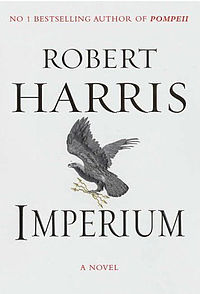
by Faith Justice | Aug 12, 2010 | Books, Fiction, Reviews
“Imperium: a Novel of Ancient Rome” by Robert Harris
 From the opening pages:
From the opening pages:
“Imperium—the power of life and death as vested by the state in an individual. Many hundreds of men have sought this power, but Cicero was unique in the history of the republic in that he pursued it with no resources to help him apart from his own talent. He was not, unlike Metellus or Hortensius, from one of the great aristocratic families, with generations of political favors to draw on at election time. He had no mighty army to back up his candidacy, as did Pompey or Caesar. He did not have Crassus‘ vast fortune to smooth his path. All he had was his voice—and by sheer effort of will he turned it into the most famous voice in the world.”
A Little History
Imperium is the first in a trilogy of novels about the life and times of Marcus Tullius Cicero, one of Republican Rome’s most famous orators and politicians. The book is narrated by Tiro, Cicero’s slave and secretary, many years after Cicero’s death. Tiro existed and is thought to have lived to be a hundred years old. He was famous for creating a short hand that he used for taking notes and later was adopted by the Senate. There is considerable evidence he wrote a biography of his former master, but those books are lost to history. Harris gives him back his voice. (more…)

by Faith Justice | Jun 25, 2010 | Essays/Research, Writing
Historical Research Using Internet, Interviews and Site Visits
 In Part I of this two-part series, I talked about using books and libraries in doing historical research. Although print matter is a good place to start, in today’s world you can’t ignore the Internet. But there are two problems: quantity and quality – too much of the former and not enough of the latter. Unlike traditionally published books, which have to go through some screening process (in academic circles that can be quite rigorous), anyone can put anything up on the Net and pass it off as truth. So what’s a good historical fiction writer to do?
In Part I of this two-part series, I talked about using books and libraries in doing historical research. Although print matter is a good place to start, in today’s world you can’t ignore the Internet. But there are two problems: quantity and quality – too much of the former and not enough of the latter. Unlike traditionally published books, which have to go through some screening process (in academic circles that can be quite rigorous), anyone can put anything up on the Net and pass it off as truth. So what’s a good historical fiction writer to do?
Stick to sites that have some stake in maintaining their reputation for accuracy such as universities and historical, archaeological and professional societies. Many sites not only update articles, but blog and tweet as well. Others aggregate the news. The Archaeological Institute of America has a daily update of archaeology in the news. When you find interesting aggregators, subscribe to their RSS feed, get email alerts or tweets when new information is posted. Google also has Google Scholar (click on the “more” button at the Google.com home page) that searches professional and scholarly literature. Many newspapers and local government organizations have digitized their archives and can be a great source of primary material. (Remember your best friend the research librarian? Tap them for help on accessing those databases.)
(more…)

by fljustice | May 18, 2010 | Essays/Research, Writing
The Devil’s in the Historical Details, Part I: Books and Libraries
 So I’m writing a book set in 5C Alexandria. I know the plot and my characters intimately. I’m typing away at the seduction scene when I think, “Did they have underwear back then or go commando? If they did, what was it like?” What about outerwear? I know the handsome hero doesn’t unzip his pants but does he unbutton, unbuckle, untie, unwrap? Of course I could finesse this with a sentence like, “He dropped his garments onto the floor.” But it won’t be long before readers get impatient with generalities because the devil is in the historical details.
So I’m writing a book set in 5C Alexandria. I know the plot and my characters intimately. I’m typing away at the seduction scene when I think, “Did they have underwear back then or go commando? If they did, what was it like?” What about outerwear? I know the handsome hero doesn’t unzip his pants but does he unbutton, unbuckle, untie, unwrap? Of course I could finesse this with a sentence like, “He dropped his garments onto the floor.” But it won’t be long before readers get impatient with generalities because the devil is in the historical details.
The sights, smells, sounds and descriptions of clothes, food, housing and transportation in a different time make the reader suspend disbelief and join whole-heartedly in the fiction. Valerie Anand, who writes historical mysteries under the pseudonym Fiona Buckley makes this point: “When planning a specific book, I read works on the period, and chase up such details as the layout of particular towns, styles of furniture, fashions of the time, laws in force, and technologies which existed then. I use maps a lot. I had my sitting room floor completely carpeted while I tried to work out whether one could or could not ride a horse from one point to another in a single day. I always try to be accurate, because there is always someone out there who will write in and point out your mistakes.”
(more…)


